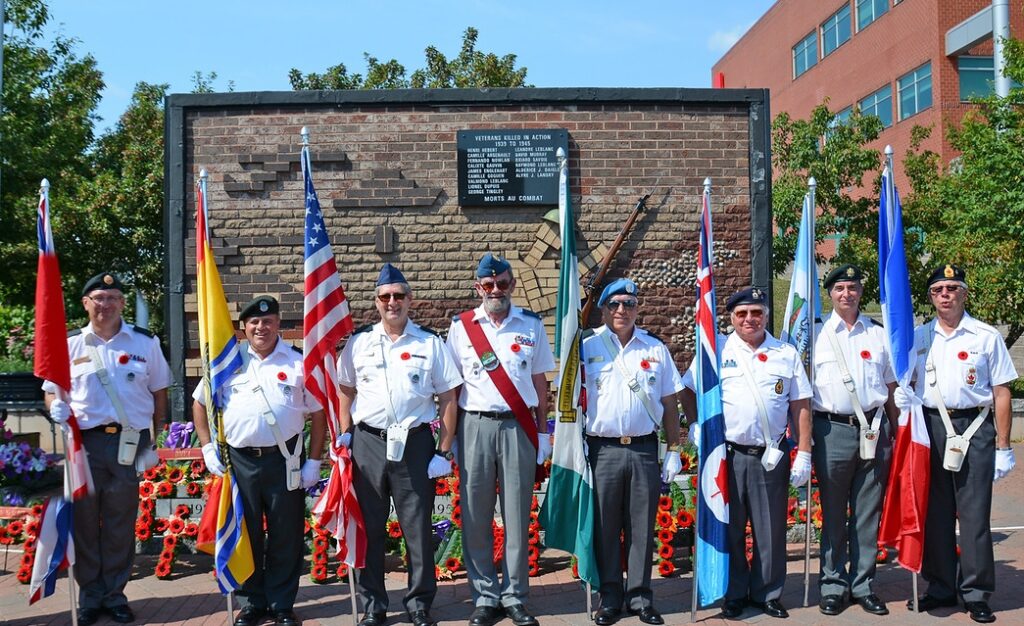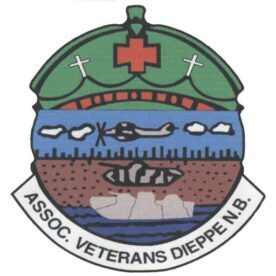Our cenotaph
The story of our cenotaph

Our cenotaph
Within six weeks of the first gathering of Dieppe area veterans, the new Dieppe Military Veterans’ Association is ready to act. Its members meet on November 6, 1979, to focus their efforts on the task of creating a Cenotaph.
But there are still unanswered questions to deal with. Who will finance the project? What will it cost? How is the goal going to be achieved when only 46 of the approximately 125 veterans living in Dieppe attend the meeting? The veterans know that it will be months before their dream sees the light of day.
A contribution from abroad
It is very likely that the Cenotaph would have a very different look if it hadn’t been for a chance visit by a journalist from Dieppe, France, in 1980. Upon returning to France, Alain Gillette, writes an article on the Town of Dieppe in Les informations dieppoises, published the French port. He also mentions plans for a Cenotaph in the New Brunswick community. He suggests that it might be interesting if stones from the beaches of Dieppe, France, were incorporated in the design of the monument the Association wants to build to commemorate the sacrifice of Canadian soldiers and cement the budding relationship between the two Dieppes. Alain Gilette’s idea strikes a sensitive chord in the hearts and minds of the people of Dieppe, France, and the surrounding area. The suggestion of collecting and sending the stones to Canada is welcomed with enthusiasm.
In the fall of 1980, children from schools in the Dieppe area ~ Berneval, Ste-Marguerite-sur-Mer, Hautot-sur-Mer (Pourville), St-Martin-en-Campagne and Puys ~ are given a day off to collect hundreds of stones from local beaches. These large shale pebbles, on which so many Canadians spilled their blood and lost their lives in their fight against Nazi tyranny, came to represent each Canadian soldier killed during the raid on August 19, 1942. Arrangements are made with Air Canada to transport the shipment to Canada without cost. On December 31, 1980, Mayor Clarence Cormier receives a letter explaining the actions of the children. The shipment arrives in Montreal early in 1981. Mr. Cormier picks up the precious cargo from the Montreal airport and brings it back to Dieppe. This contribution by children on the other side of the Atlantic gives renewed vigour to the veterans’ efforts. In January, members of the Association meet with Jean Gaudet, director of Recreation and Community Services for the Town of Dieppe, to discuss the Cenotaph project.
The design of the Cenotaph
In February, Nelson Monuments, a private firm, Gordon Brown, a draftsman, and Donald Gould, a local World War II veteran and mason by trade, submit sketches for the Cenotaph. All incorporate the stones gathered by the school children in France.
The cost of the monument is a major factor in deciding who will build it. It is feared that the submission from outside the Dieppe area will bring the price of construction to more than $ 30,000.
After a few minor changes, the green light is given to the design submitted by Donald Gould from Dieppe. It depicts a scene from the Canadian led raid on the port of Dieppe on August 19, 1942. Donald Gould is awarded a contract for $ 8,950. The work will be done under the direction of Alfred Melanson who is appointed Chairman of the Cenotaph Committee.
It is now necessary to generate the funds necessary for the project. The Association decides to sell badges each representing a brick of the Cenotaph. Wilfred Gauvin heads the fund-raising committee whose goal it to sell 4,000 badges at $3.00 each. If the $ 12,000 objective is reached, there will be sufficient funds to build the monument. Notices are placed in the church bulletins, letters outlining the project are sent out and veterans conduct door to door canvassing.
In April, a new partner joins the project. The Dieppe Lions Club accepts sponsorship of the Cenotaph and organizes other fund-raising activities. All that is now needed is a decision on the location. The veterans want a site set back from the street. The ideal location is an empty piece of municipal property facing Acadia Avenue near the Dieppe Town Hall. The Town agrees to the request.
The sod turning ceremony takes place on the evening of May 8, 1981, the 36th anniversary of the end of fighting in Europe. The French Consul general in Moncton, Mr. Eric Lem, officially hands over the stones gathered in France to the Town of Dieppe and the drawing of the Cenotaph is unveiled by Mayor Clarence Cormier and the President of the Veterans’ Association, Mr. Ben Gallant. The sod turning ceremony is followed by a reception at the Lions Club. Construction begins within days, but it will be six months before the veterans and the public see the final results.
Unveiling ceremonies
The unveiling of the Cenotaph takes place on November 8. Special guests in attendance include Brigadier-General Owen Lockyer, Colonel J. D. Murray, Commanding Officer of C.F.B. Moncton, Mr. Phil Howlett, a veteran who had been taken prisoner during the Dieppe Raid, Mr. Bill Malenfant, M.L.A., Mr. Eric Lem, French Consul general, Mayor Clarence Cormier, Archbishop Donat Chiasson, Reverend Hamilton, Rabbi Lefkowitz, Father Doucet, Councillor Ben Gallant and, representing the Dieppe Lions Club, Mr. Fred Melanson, and Mr. Roger Thériault.
A bugler plays “The Last Post”. A minute of silence is observed for comrades who fell on the field of honour before the dedication of the new Cenotaph takes place. Wreaths are then placed including one by Mrs. Philomène Lavoie, a Silver Cross mother, who lost her son Honoré Émile (died on December 31, 1943, in Italy). The ceremony ends with the playing of “God Save the Queen”. Following the ceremony, the Dieppe Military Veterans’ Association is joined by other military associations from Moncton and Riverview and elements from the Town of Dieppe police and fire departments in a March Past to the music of the Cadet band. More than 700 people attend the ceremony.
The Cenotaph
The Cenotaph commemorates comrades in arms who fell during World War I, World War II, the Korean War as well as Peacekeepers. The monument rests on a granite base and measures 14 feet 9 inches wide (4.5m), 10 feet 8 inches high (3.25m) and is 20 inches (50 cm) thick. It comprises 40 rows of 21 bricks. Ten patches of stones, gifts from the children of the Dieppe area in France, are integrated in the brick scenery to represent the fatal casualties of the 10 Canadian Units which took part in the raid on August 19, 1942. In the centre of the memorial, a stylised soldier, complete with authentic period helmet and Lee-Enfield .303 rifle, the standard infantry weapon of World War II, races towards the cliffs of Dieppe. A Churchill tank appears from the left and a ship can be seen on the water. A stylized aircraft, representing the Royal Canadian Air Force, flies among white and grey clouds pierced by anti-aircraft fire. The earth is dark brown and rock formations represent the beach. The black contour represents the letters, with black borders, received by families informing them of the death of a loved one in combat.
Even though the Cenotaph is illustrated with the theme of the Dieppe Raid, the carving on the granite base, added in 2000, serves to commemorate all Canadians who served their country in time of war and on Peacekeeping duties: 1914-1918, 1939-1945, 1950-1953 and Gardien de la Paix /Peacekeeping.
A plaque honouring the 15 residents of Dieppe who died during their service to Canada during World War II is added later. (To view the names and details, go to http://ca.geocities.com/dieppe-vets@rogers.com/last.htm )
On the rear of the monument are the names of the deceased Dieppe veterans with the inscription “In memory of departed comrades – Dieppe Veterans’ Association of New Brunswick”. The date of the unveiling, the names of Don Gould and Son for the design and construction of the
Cenotaph, the Lions Club, and the people of Dieppe for having built the Cenotaph are also inscribed here. On the granite base, poppies flank the immortel phrase “Lest we forget / Nous nous souviendrons d’eux”.
Black marble slabs on both ends of the Cenotaph are added in 2001. Etched with a white cross and the Star of David, they remind us of the war cemeteries bearing the names of Canadians who died for their country. The slabs also bear the crest of the Dieppe Military Veterans’ Association with the inscription, in English on one end and in French on the other, “In memory of those who left Dieppe and spilled their blood and for the veterans who fought for our liberty”.
A sense of pride
The Cenotaph has become a symbol of pride for the Dieppe Military Veterans’ Association, the citizens of the City of Dieppe and many veterans from across Canada and abroad. It is a rallying point for ceremonies of remembrance, the most important being the anniversary of the Dieppe Raid, held on the Sunday nearest August 19, and Remembrance Day, on November 11.
For the first time, a Cenotaph is created solely by members of a veterans’ association. It is the only memorial in Canada to speak eloquently of the raid on the port of Dieppe, France, a very controversial operation in the military annals of World War II.
For the veterans, the participation of the children of France in collecting the stones from the beaches of the Dieppe area carries a very special meaning and is a special gift. In their letter to the veterans, they wrote: “For an end to all wars, for friendship among children”.
This first project of the Dieppe Veterans( Association puts the organization on solid ground and results in the establishment of a permanent structure and rallies new members.
In the fall of 1983, lawyer Brigitte Robichaud prepares the request for the Charter of the Association which is signed Benjamin Gallant, Amédée Cormier, Marcel Cormier and Thomas LeBlanc. The Charter is granted by Justice Minister Fernand Dubé on September 20, 1983. The Association is officially incorporated as “Association des Vétérans de Dieppe Inc.” and “Dieppe Military Veterans’ Association”.
The Association is now ready to take on new challenges.
